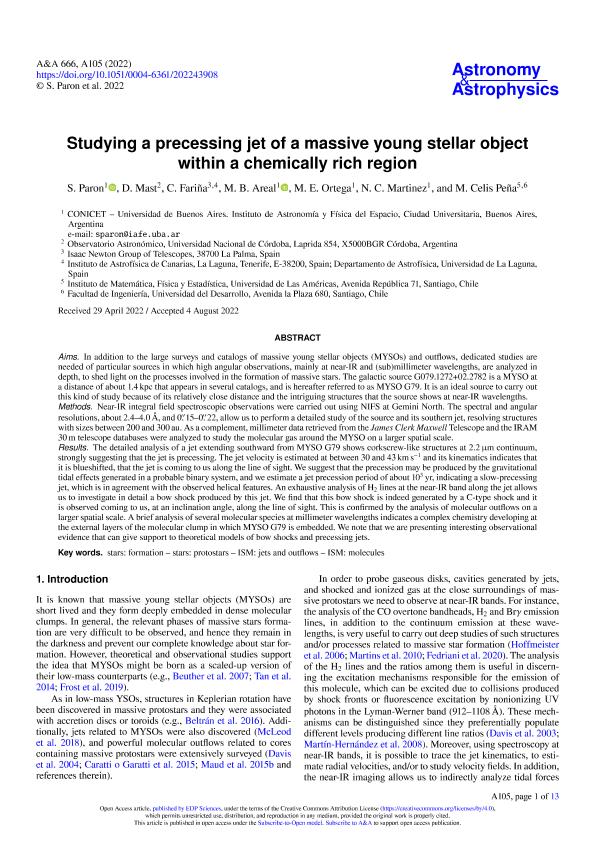Artículo
Studying a precessing jet of a massive young stellar object within a chemically rich region
Paron, Sergio Ariel ; Mast, Damian
; Mast, Damian ; Fariña, C.; Areal, María Belén
; Fariña, C.; Areal, María Belén ; Ortega, Martin Eduardo
; Ortega, Martin Eduardo ; Martinez, Naila Constanza
; Martinez, Naila Constanza ; Celis Peña, M.
; Celis Peña, M.
 ; Mast, Damian
; Mast, Damian ; Fariña, C.; Areal, María Belén
; Fariña, C.; Areal, María Belén ; Ortega, Martin Eduardo
; Ortega, Martin Eduardo ; Martinez, Naila Constanza
; Martinez, Naila Constanza ; Celis Peña, M.
; Celis Peña, M.
Fecha de publicación:
10/2022
Editorial:
EDP Sciences
Revista:
Astronomy and Astrophysics
ISSN:
0004-6361
Idioma:
Inglés
Tipo de recurso:
Artículo publicado
Clasificación temática:
Resumen
Aims. In addition to the large surveys and catalogs of massive young stellar objects (MYSOs) and outflows, dedicated studies are needed of particular sources in which high angular observations, mainly at near-IR and (sub)millimeter wavelengths, are analyzed in depth, to shed light on the processes involved in the formation of massive stars. The galactic source G079.1272+02.2782 is a MYSO at a distance of about 1.4 kpc that appears in several catalogs, and is hereafter referred to as MYSO G79. It is an ideal source to carry out this kind of study because of its relatively close distance and the intriguing structures that the source shows at near-IR wavelengths. Methods. Near-IR integral field spectroscopic observations were carried out using NIFS at Gemini North. The spectral and angular resolutions, about 2.4- 4.0, and 0.′15- 0.′22, allow us to perform a detailed study of the source and its southern jet, resolving structures with sizes between 200 and 300 au. As a complement, millimeter data retrieved from the James Clerk Maxwell Telescope and the IRAM 30 m telescope databases were analyzed to study the molecular gas around the MYSO on a larger spatial scale. Results. The detailed analysis of a jet extending southward from MYSO G79 shows corkscrew-like structures at 2.2 μm continuum, strongly suggesting that the jet is precessing. The jet velocity is estimated at between 30 and 43 km s-1 and its kinematics indicates that it is blueshifted, that the jet is coming to us along the line of sight. We suggest that the precession may be produced by the gravitational tidal effects generated in a probable binary system, and we estimate a jet precession period of about 103 yr, indicating a slow-precessing jet, which is in agreement with the observed helical features. An exhaustive analysis of H2 lines at the near-IR band along the jet allows us to investigate in detail a bow shock produced by this jet. We find that this bow shock is indeed generated by a C-type shock and it is observed coming to us, at an inclination angle, along the line of sight. This is confirmed by the analysis of molecular outflows on a larger spatial scale. A brief analysis of several molecular species at millimeter wavelengths indicates a complex chemistry developing at the external layers of the molecular clump in which MYSO G79 is embedded. We note that we are presenting interesting observational evidence that can give support to theoretical models of bow shocks and precessing jets.
Palabras clave:
ISM: JETS AND OUTFLOWS
,
ISM: MOLECULES
,
STARS: FORMATION
,
STARS: PROTOSTARS
Archivos asociados
Licencia
Identificadores
Colecciones
Articulos(CCT - CORDOBA)
Articulos de CTRO.CIENTIFICO TECNOL.CONICET - CORDOBA
Articulos de CTRO.CIENTIFICO TECNOL.CONICET - CORDOBA
Articulos(IAFE)
Articulos de INST.DE ASTRONOMIA Y FISICA DEL ESPACIO(I)
Articulos de INST.DE ASTRONOMIA Y FISICA DEL ESPACIO(I)
Citación
Paron, Sergio Ariel; Mast, Damian; Fariña, C.; Areal, María Belén; Ortega, Martin Eduardo; et al.; Studying a precessing jet of a massive young stellar object within a chemically rich region; EDP Sciences; Astronomy and Astrophysics; 666; 10-2022; 1-13
Compartir
Altmétricas



